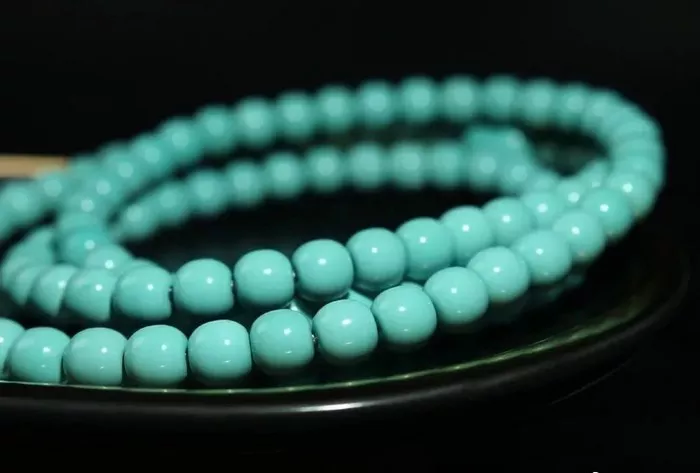Turquoise, with its captivating blue-green hues, has been cherished for centuries for its aesthetic and cultural significance. However, what is the turquoise crystal called precisely? In this comprehensive article, we will explore the origin and identity of the turquoise crystal, its history, properties, and the role it plays in various aspects of human culture and society.
Turquoise: Nature’s Gemstone
Turquoise is a gemstone renowned for its vibrant and captivating blue-green color. It has been admired and utilized by various cultures around the world for thousands of years. Known for its unique blend of colors, turquoise can range from sky blue to greenish-blue, often displaying intricate matrix patterns.
The Identity of the Turquoise Crystal
The turquoise crystal, in its mineral form, is called “turquoise.” Turquoise is classified as a hydrated phosphate mineral, primarily composed of copper, aluminum, and phosphorus. Its chemical formula is CuAl6(PO4)4(OH)8·4H2O, indicating the presence of copper, aluminum, phosphorus, oxygen, and water molecules within its crystal structure.
Turquoise’s Geological Origins
To understand the formation of the turquoise crystal, it’s essential to delve into its geological origins:
1. Hydrothermal Activity:
Turquoise typically forms within arid regions with significant hydrothermal activity. The presence of mineral-rich groundwater is crucial for the development of turquoise deposits.
2. Copper Interaction:
Copper plays a pivotal role in the formation of turquoise. It leaches from nearby rocks and minerals, dissolving into groundwater. As the copper-rich water interacts with aluminum and phosphorus minerals in the host rock, turquoise begins to crystallize.
3. Porosity and Matrix:
Turquoise often forms as nodules or veins within host rocks, such as limonite or sandstone. These host rocks can contain distinctive matrix patterns, which add character to the turquoise gemstone.
4. Coloration:
The coloration of turquoise is influenced by the presence of copper ions. Variations in the copper content, as well as the surrounding geological conditions, lead to the wide spectrum of turquoise colors, from blue to green.
Turquoise Through History
Throughout history, turquoise has held a special place in the hearts of diverse cultures across the globe:
1. Ancient Egypt:
Turquoise was highly prized by the ancient Egyptians, who used it in jewelry and amulets. It was associated with protection, good fortune, and the afterlife.
2. Native American Cultures:
Turquoise has deep cultural significance for many Native American tribes. It was used in jewelry, talismans, and ceremonial objects. Different tribes had various beliefs about turquoise, but it was generally seen as a symbol of protection, healing, and connection to the spiritual world.
3. China:
Turquoise has been treasured in China for centuries, symbolizing wealth, prosperity, and good fortune. It was used in jewelry, carvings, and as an adornment for religious objects.
Properties of Turquoise
Turquoise is a captivating gemstone prized for its unique properties. It exhibits a wide range of blue and green hues, often displaying intricate matrix patterns. Turquoise ranks between 5 and 6 on the Mohs scale, making it relatively soft and suitable for carving. High-quality turquoise is often semi-translucent, allowing light to enhance its beauty. To improve color and durability, turquoise is commonly stabilized, enhanced, and waxed. Beyond its physical attributes, turquoise holds metaphysical significance, associated with inner peace, communication, and spiritual grounding. It’s valued for its protective qualities, cultural symbolism, and role in holistic practices, making it a cherished gemstone with both aesthetic and spiritual appeal.
See Also: What is blue turquoise good for: The Spiritual & Healing Power
Turquoise in Modern Jewelry
Turquoise remains a popular choice in contemporary jewelry design, appreciated for its natural beauty and cultural significance. It is used in various forms, including:
1. Turquoise Rings:
Turquoise rings are a classic choice, often featuring cabochon-cut stones set in silver or gold settings.
2. Turquoise Necklaces:
Turquoise necklaces can be simple or elaborate, with turquoise beads or focal pendants.
3. Turquoise Earrings:
Turquoise earrings come in various styles, from studs to dangles, allowing for versatility in accessorizing.
Cultural and spiritual significance of turquoise
Turquoise holds profound cultural and spiritual significance across diverse traditions. In Native American cultures, it’s a sacred stone symbolizing protection, healing, and spiritual connection. Persians consider it a safeguard against malevolent forces. Holistic practices associate turquoise with inner peace, emotional balance, and clear communication. It aligns with the throat and heart chakras, fostering expression and harmony. Many cultures view turquoise as a protective amulet, warding off negative energies. Its vivid color and cultural history have made it a symbol of wealth, prosperity, and good fortune in various societies, making turquoise not just a gemstone but a profound emblem of cultural and spiritual heritage.
Turquoise Enhancement and Stabilization
It is common for turquoise to undergo treatments to enhance its color and durability:
1. Stabilization:
Many turquoise specimens are stabilized to improve their hardness and prevent color change over time. Stabilization involves impregnating the stone with a clear resin.
2. Enhancement:
Some turquoise is enhanced with dyes or coatings to intensify its color. This process is known as “reconstitution.”
3. Waxing and Polishing:
Turquoise is often waxed and polished to enhance its luster and surface smoothness.
4. Backing:
To improve the appearance of lower-grade turquoise, it may be backed with a layer of other materials.
These treatments are widely accepted in the gemstone industry and are considered standard practices. They help preserve the natural beauty of turquoise while making it more suitable for use in jewelry and art.
See Also: Does Gray Go with Turquoise: A Pairing of Elegance
Conclusion
Turquoise, in its mineral form, is indeed called “turquoise.” This remarkable gemstone, with its rich history, cultural significance, and captivating colors, holds a cherished place in human culture and society. From its geological origins deep within the Earth to its role in spiritual and healing practices, turquoise continues to be a jewel of both nature and culture. Its enduring popularity in jewelry, art, fashion, and interior design serves as a testament to its timeless beauty and enduring charm. Whether worn as a symbol of protection,


